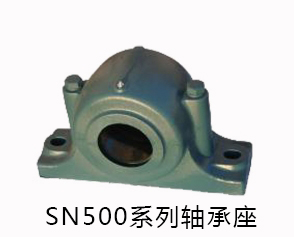The difficulty in bearing lubrication is that the lubricant is easy to fly away and not easy to adhere to the rolling surface, or it is blocked by the high-speed airflow around the bearing and cannot enter the bearing. However, the lubricant entering the bearing at too high a speed can sometimes cause damage to the shaft, such as pitting and scaling of the cage, which exacerbates friction and wear.
The working temperature of bearings is mostly around 200 ℃, and often higher. Without strong cooling, the temperature will continue to rise, which is greatly detrimental to the strength and hardness of the bearing. Once the bearing loses its ability to maintain shape, it will inevitably exacerbate high-speed friction and cause a rapid rise in temperature, further leading to a reduction in material strength and hardness, which will quickly lead to bearing failure.
Due to the sensitivity of bearings to wear and the tendency to generate debris, if not removed from the bearings in a timely manner, it will also create a vicious cycle and cause rapid bearing failure.
Therefore, the bearing lubrication task of the bearing adapter manufacturer must effectively deliver the lubricant to the moving surface in the bearing, remove heat from the bearing, and remove debris or dirt from the bearing.
The commonly used lubrication methods and effective lubricants in high-speed bearings are as follows:
Spray lubrication method
Spray lubrication is a method of injecting lubricating oil into the bearing at a speed of 10-20 m/s from a small nozzle hole close to the bearing, usually into the gap formed between the cage and the inner or outer ring, to lubricate and cool the bearing.

For small ball bearings with an inner diameter of 30-35 mm, the maximum dmn value that can be achieved by spray lubrication is 3 million, while for larger bearings, it is 2.5 million.
"Double or multi orifice nozzles can not only increase the amount of oil supplied, but also improve the efficiency of using lubricating oil. Multiple nozzles or having nozzles on both ends can improve the effectiveness of lubrication and cooling. However, when the dmn value approaches 2 million, due to the influence of centrifugal inertia and wind resistance, the oil fed into the bearing is only 70% or less of the nozzle flow.".
2. Under ring lubrication method
The under-ring lubrication method utilizes centrifugal inertia to directly spray oil onto the raceway surface through many radial holes opened in the inner ring, and a portion of the oil flows axially below the inner ring to achieve the purpose of cooling the inner ring. The oil entering the raceway flows out through two channels, one on the left and the other on the right, to wash away the debris falling from the cage and other parts.
This lubrication method uses much less oil than oil injection lubrication, resulting in less power loss due to the dynamic stirring of the oil, and greatly improving the heating condition of the bearings. Even the inner ring temperature may be lower than the outer ring, reducing the bearing failure rate.
This lubrication method can also be used to cool the outer ring. When both the inner and outer rings receive this lubrication, the allowable dmn value of the bearing can be further increased.
Nowadays, this under-ring lubrication method is widely used in various ultra-high speed running situations. The achievable * * * dmn value is 3 million for large ball bearings with an inner diameter of 120 to 200 mm; 2.4 million for tapered roller bearings with an inner diameter of 120 mm, and 3 million for short cylindrical roller bearings with combined inner rings.
3. Double lubrication method
This method essentially consists of forming a hydrostatic oil film sliding bearing with the inner ring hole and journal of the rolling bearing, which greatly reduces the rotational speed of the rolling bearing, thereby achieving the goal of reducing the centrifugal force. Such a dual lubrication bearing can significantly reduce the rotational speed of the inner ring of the rolling bearing, thereby allowing the spindle to have a higher rotational speed, equivalent to a further increase in the dmn value of the bearing.
4. Oil gas lubrication method
The advantage of the oil gas lubrication method is that it is possible to achieve a high speed with a dmn value of 800000 to 1500000 only by reducing the friction of the bearing without changing the bearing structure. The advantage of this method is even more significant for bearings with more internal sliding.
(1) The principle and characteristics of oil gas lubrication is to use a quantitative piston distributor to intermittently discharge very small amounts of oil (such as 0.01 m1) over a weekly period. The discharged oil forms a continuous liquid flow before reaching the bearing and is sent into the bearing with air.
The characteristics of oil gas lubrication are as follows:
1) It can continuously and stably supply a very small amount of quantitative oil to the bearings, so it can control the necessary minimum amount of oil like lubricating grease. Due to the different types of bearings and the different amount of lubricating oil required, a quantitative piston pipe is connected to each set of bearings, which can adjust the oil supply amount of each bearing.
The dynamic friction loss of this lubrication method is about one tenth of that of jet lubrication, and its dynamic friction loss and temperature rise are also smaller than those of grease lubrication.
2) Due to the fact that oil and gas lubrication requires less oil than jet lubrication, and the lubricating oil flows into the bearings with suitable oil droplets, there is less atmospheric pollution. For example, after placing an oil gas lubricated spindle in a propylene tank for continuous operation for about 2 hours, the air pollution level in the measurement tank is only 0.03mg/m3.
3) It is difficult for foreign dust or cutting fluid to enter the main shaft, which is due to the large amount of air (20-30L/min per bearing) supplied with a small amount of oil, which increases the internal pressure of the main shaft.
(2) The amount and viscosity of oil and gas lubricated bearings should be supplied with the necessary minimum amount of oil, so the selection of the amount of oil is crucial.
Angular contact ball bearings with more sliding have more oil than cylindrical roller bearings with less sliding. There are formulas for the approximate standard of fuel supply.
However, the lower the viscosity of the oil, or the higher the rotational speed, the corresponding increase in the amount of oil required. In fact, the amount of oil should be determined based on service conditions such as bearing load and rotational speed.
In terms of the influence of lubricating oil viscosity on bearing temperature rise, oil air lubrication is much smaller than circulating oil supply. However, under the same fuel supply conditions, when the viscosity is high, the temperature rise slightly increases. Generally, oil with a viscosity of 10-3C mrn2/s is used for oil gas lubrication at 40 ℃.
Air lubrication is a newly developed lubrication method with multiple characteristics. It is used in bearings with more sliding, such as angular contact bearings, with a dmn value of around 1.5 million.
5. Lubricant for bearings
The lubricant for bearings should be considered as the lubricant for high-temperature bearings, that is, synthetic oil with good performance at high temperatures or grease based on this synthetic oil should be selected. MIL-L-7808 and MIL-L-23699 diester oils are widely used in jet engine bearings.

 | Mobile:15061431555 13951550599 15366460599 |
 | Fax:0515-86621099 |
 | Tel:0515-86622862 |
 | Address:Zhi'er Road, Kaiyuan Industrial Park, Xiangshui Economic Development Zone |